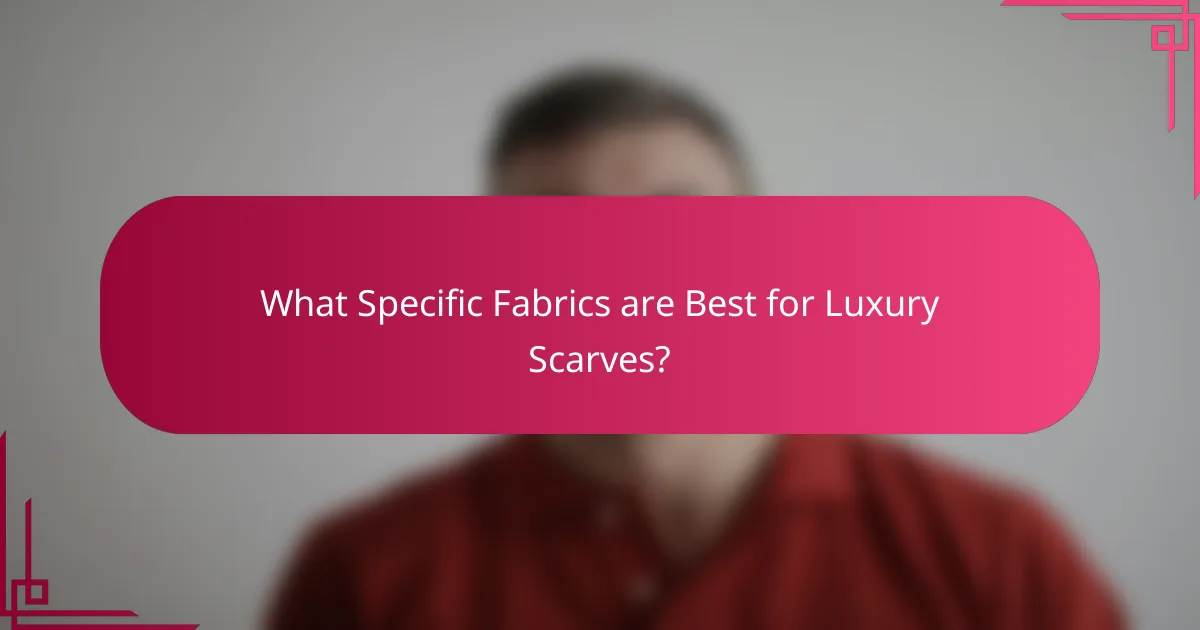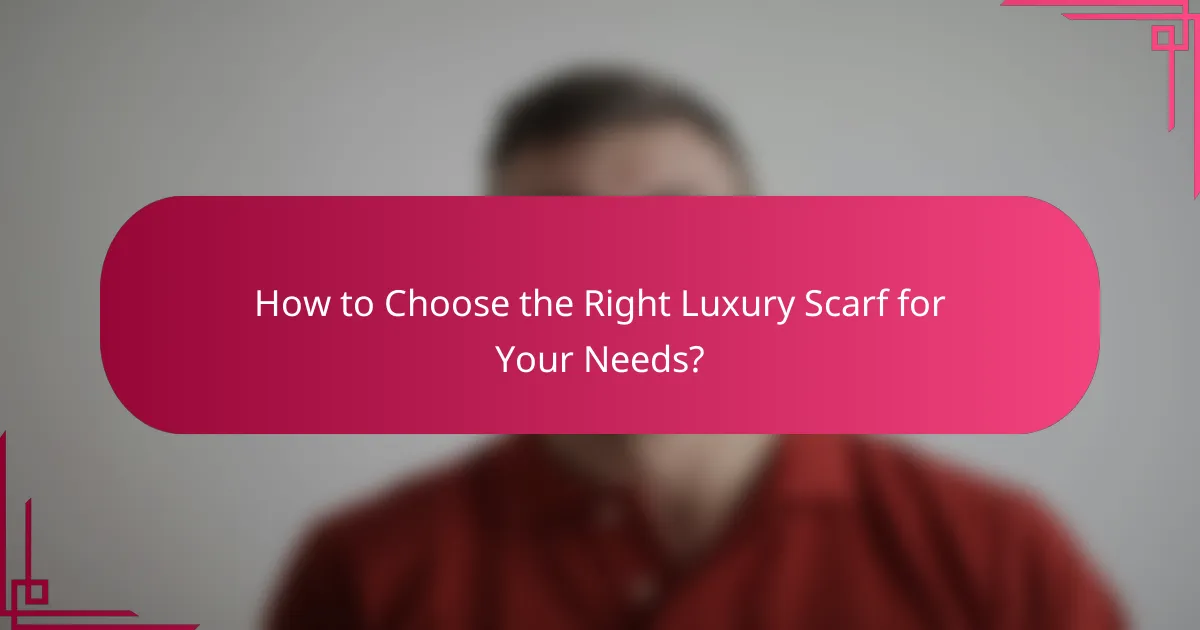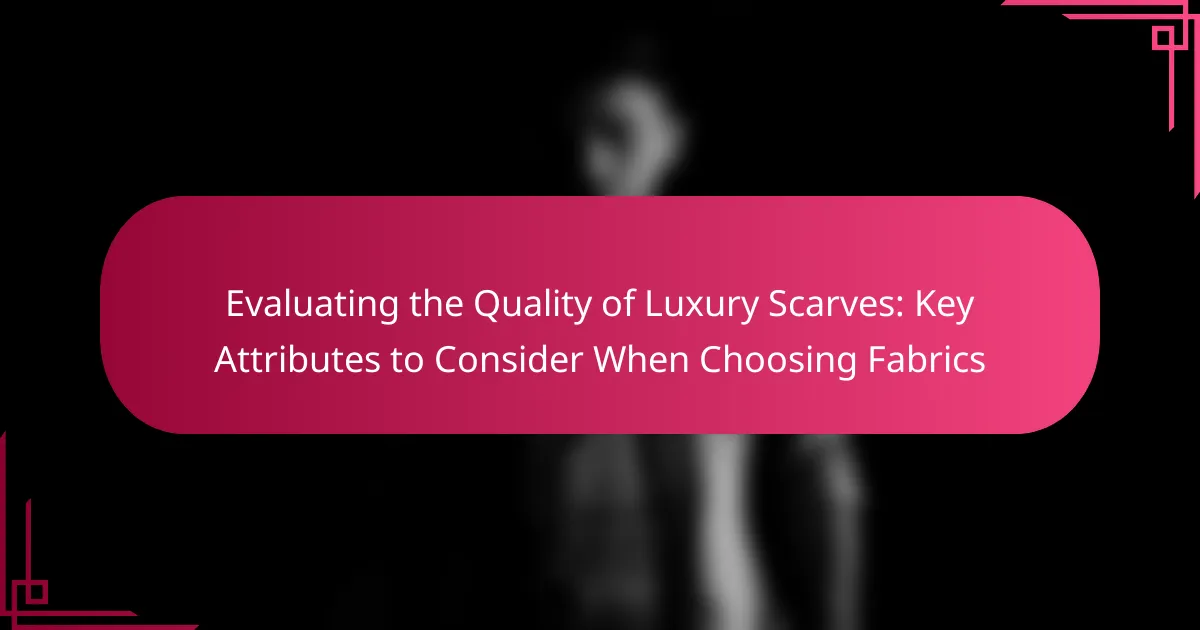Luxury scarves are high-quality fashion accessories crafted from premium materials such as silk, cashmere, and fine wool. These scarves are distinguished by their craftsmanship, intricate designs, and vibrant colors, making them both aesthetically appealing and valuable as status symbols. Essential factors to consider when selecting a luxury scarf include the type of fabric, size, design, and quality of stitching, which all contribute to the scarf’s durability and overall appeal. The article will provide insights into evaluating these key attributes to help consumers make informed choices when purchasing luxury scarves.

What are Luxury Scarves and Why are They Valued?
Luxury scarves are high-quality fashion accessories made from premium materials. They are valued for their craftsmanship, exclusivity, and aesthetic appeal. Common materials include silk, cashmere, and fine wool. These fabrics provide softness, warmth, and durability. The intricate designs often feature unique patterns and vibrant colors. Luxury scarves also serve as status symbols in fashion. Their limited availability enhances their desirability. The craftsmanship involved in creating these scarves often includes hand-rolled edges and detailed stitching. This attention to detail significantly contributes to their overall value.
How do Luxury Scarves differ from Regular Scarves?
Luxury scarves differ from regular scarves primarily in quality, materials, and craftsmanship. Luxury scarves are often made from high-end fabrics like cashmere, silk, or fine wool. Regular scarves typically use more common materials such as acrylic or polyester. The craftsmanship of luxury scarves includes meticulous attention to detail and often features hand-stitched elements. Regular scarves may have simpler construction methods. Additionally, luxury scarves often come from renowned brands, which adds to their exclusivity and perceived value. Regular scarves are usually mass-produced and widely available. The price point for luxury scarves is significantly higher, reflecting their quality and brand prestige.
What materials are commonly used in Luxury Scarves?
Luxury scarves are commonly made from materials such as silk, cashmere, wool, and modal. Silk is prized for its softness and sheen, making it a popular choice for high-end scarves. Cashmere is known for its warmth and lightweight feel, providing both comfort and elegance. Wool offers durability and insulation, suitable for colder climates. Modal, a semi-synthetic fiber, is appreciated for its smooth texture and drape. These materials are often blended to enhance their properties, ensuring luxury scarves meet quality standards.
What craftsmanship techniques contribute to their luxury status?
Handcrafted techniques such as hand-looming and intricate embroidery contribute significantly to the luxury status of scarves. Hand-looming allows for unique patterns and textures that cannot be replicated by machines. This technique often involves skilled artisans who use traditional methods passed down through generations. Intricate embroidery adds a level of detail and artistry that elevates the overall aesthetic. The use of high-quality materials, such as silk and cashmere, further enhances the luxurious feel. Each scarf may take several hours or even days to complete, showcasing the time and effort invested. Limited production runs often accompany these techniques, ensuring exclusivity. The combination of these craftsmanship techniques results in a product that embodies luxury and sophistication.
What Key Attributes Should You Consider When Evaluating Luxury Scarves?
Key attributes to consider when evaluating luxury scarves include material, craftsmanship, brand reputation, design, and care instructions. Material impacts the scarf’s feel, warmth, and durability. Common high-quality materials are silk, cashmere, and wool. Craftsmanship refers to the attention to detail in stitching and finishing. A well-crafted scarf will have clean edges and no loose threads. Brand reputation reflects the quality and prestige associated with the brand. Renowned brands often use superior materials and craftsmanship. Design encompasses the aesthetic appeal, including patterns and colors. Lastly, care instructions indicate how to maintain the scarf’s quality over time. Following these attributes ensures a well-informed purchase.
How does Fabric Composition affect the quality of Luxury Scarves?
Fabric composition significantly affects the quality of luxury scarves. Different materials provide varying levels of softness, durability, and warmth. For instance, silk offers a smooth texture and a luxurious feel. Wool provides warmth and resilience, making it suitable for colder climates. Cashmere is known for its exceptional softness and lightweight properties. The blend of fibers can enhance the overall quality. A higher percentage of natural fibers typically results in superior quality. Additionally, the fabric’s breathability and drape are influenced by its composition. These factors ultimately determine how the scarf feels against the skin and how it drapes when worn.
What role does Weave Type play in determining the quality?
Weave type significantly influences the quality of luxury scarves. Different weave types can affect texture, durability, and appearance. For instance, a twill weave provides a soft drape and is less prone to fraying. In contrast, a plain weave may offer a more rigid structure but can lack the same level of comfort. The choice of weave also impacts the scarf’s ability to hold color and resist wrinkles. High-quality scarves often feature intricate weaves that enhance both aesthetic appeal and longevity. Research indicates that scarves with complex weaves, such as jacquard, exhibit superior quality due to their detailed patterns and robust construction.
Why is Understanding Fabric Quality Important for Luxury Scarves?
Understanding fabric quality is crucial for luxury scarves because it directly impacts their durability, appearance, and feel. High-quality fabrics enhance the overall aesthetic and provide a luxurious tactile experience. Luxury scarves often use materials like silk, cashmere, or fine wool, which are known for their softness and sheen. These fabrics also resist wear and maintain their shape over time. Poor fabric quality can lead to pilling, fading, and a less elegant look. Investing in high-quality materials ensures that the scarf retains its value and appeal. According to a study by the Textile Research Journal, the type of fabric significantly influences consumer perception of luxury and quality.
How can Fabric Weight influence the feel and durability of a Luxury Scarf?
Fabric weight significantly influences the feel and durability of a luxury scarf. A heavier fabric typically provides a more luxurious, substantial feel against the skin. This weight contributes to the scarf’s ability to drape elegantly, enhancing its aesthetic appeal.
In terms of durability, heavier fabrics often withstand wear and tear better than lighter options. For instance, a scarf made from a dense wool blend can resist fraying and maintain its shape over time.
Conversely, lighter fabrics may feel softer and more breathable but can be more prone to damage. For example, delicate silk scarves may offer a luxurious touch but might tear more easily.
Overall, the choice of fabric weight directly impacts both the tactile experience and the longevity of luxury scarves.
What are the implications of Fabric Finish on the appearance and maintenance?
Fabric finish significantly impacts both the appearance and maintenance of luxury scarves. A well-executed finish enhances the fabric’s luster and texture, contributing to a more visually appealing product. For instance, a polished finish can create a sleek surface that reflects light, enriching the scarf’s aesthetic. Conversely, a rough or unfinished surface may appear dull and less attractive.
In terms of maintenance, different finishes require varying care methods. A water-repellent finish can help resist stains, making cleaning easier. However, some finishes may necessitate dry cleaning to preserve their quality, adding to upkeep costs. Fabrics with a soft finish often attract less dirt, while those with a textured finish may require more frequent cleaning due to their tendency to trap particles. Therefore, understanding the implications of fabric finish is crucial for both appearance and maintenance considerations in luxury scarves.

What Specific Fabrics are Best for Luxury Scarves?
Silk, cashmere, and merino wool are the best fabrics for luxury scarves. Silk offers a smooth texture and natural luster. It is lightweight and breathable, making it suitable for various climates. Cashmere is known for its softness and warmth. It provides excellent insulation while remaining lightweight. Merino wool is also soft and has moisture-wicking properties. This makes it comfortable for prolonged wear. These fabrics are often sourced from high-quality materials, ensuring durability and longevity. Luxury scarves crafted from these fabrics tend to maintain their appearance over time.
What are the Benefits of Natural Fibers in Luxury Scarves?
Natural fibers in luxury scarves offer several benefits. They provide superior breathability compared to synthetic fibers. This allows for better temperature regulation, keeping the wearer comfortable in various climates. Natural fibers also possess moisture-wicking properties, which help in absorbing sweat and maintaining dryness.
Additionally, they are biodegradable, making them an environmentally friendly choice. Natural fibers, such as silk and cashmere, have a luxurious feel and drape beautifully. This enhances the aesthetic appeal of luxury scarves.
Furthermore, natural fibers are often hypoallergenic, reducing the risk of skin irritation. Their durability ensures that luxury scarves can withstand wear over time, maintaining their quality. The unique texture and appearance of natural fibers add to the overall value of luxury scarves.
How does Silk enhance the luxury experience of a scarf?
Silk enhances the luxury experience of a scarf through its unique texture and luster. The smoothness of silk provides a soft, comfortable feel against the skin. This fabric drapes beautifully, creating an elegant silhouette. Silk also has a natural sheen that adds visual appeal. Its lightweight nature makes it versatile for different styles and seasons. Additionally, silk is known for its durability, maintaining its quality over time. The ability to hold vibrant colors enhances the scarf’s aesthetic value. Overall, silk elevates the perception of luxury in scarves.
What advantages do Cashmere and Wool offer?
Cashmere and wool offer several advantages for luxury scarves. Cashmere is known for its exceptional softness and warmth. It is derived from the undercoat of cashmere goats, making it lightweight yet insulating. Wool, sourced from sheep, is durable and resilient. It provides natural moisture-wicking properties and retains warmth even when wet. Both materials are breathable, ensuring comfort in various temperatures. Additionally, cashmere and wool have natural elasticity, which helps maintain shape. They are also hypoallergenic, suitable for sensitive skin. The luxurious feel of cashmere and the versatility of wool make them ideal choices for high-quality scarves.
What Synthetic Fabrics are Used in Luxury Scarves?
Luxury scarves often utilize synthetic fabrics such as polyester, nylon, and acrylic. Polyester is favored for its durability and resistance to wrinkles. Nylon offers a silky feel and is lightweight, making it ideal for elegant designs. Acrylic is known for its softness and ability to mimic wool. These synthetic fabrics provide versatility in patterns and colors. They also offer moisture-wicking properties, enhancing comfort. The use of these materials allows for a blend of style and functionality in luxury scarves.
How does Polyester compare to Natural Fibers in Luxury Scarves?
Polyester is generally more durable and resistant to wrinkles compared to natural fibers like silk or cashmere in luxury scarves. Polyester can withstand wear and tear better, making it a practical choice for everyday use. Natural fibers, however, offer superior breathability and comfort. They tend to feel softer against the skin and provide better moisture absorption.
In terms of aesthetics, natural fibers often have a richer texture and sheen, enhancing the luxury appeal. Polyester may mimic these qualities but can lack the same depth and warmth. Additionally, natural fibers are biodegradable, while polyester is synthetic and contributes to environmental concerns.
Overall, the choice between polyester and natural fibers in luxury scarves depends on the desired balance between durability and comfort.
What innovations in Synthetic Fabrics are enhancing Luxury Scarves?
Innovations in synthetic fabrics enhancing luxury scarves include advanced moisture-wicking technologies and improved breathability. These technologies allow scarves to remain comfortable in varying climates. Additionally, the use of microfibers provides a softer, silk-like feel while maintaining durability. Innovations like anti-static treatments prevent cling and enhance wearability. Eco-friendly synthetic options are also emerging, appealing to environmentally conscious consumers. Enhanced dyeing techniques improve color vibrancy and longevity. Finally, lightweight materials are being developed, offering warmth without bulk. These advancements collectively elevate the quality and appeal of luxury scarves.

How to Choose the Right Luxury Scarf for Your Needs?
To choose the right luxury scarf for your needs, consider the fabric type, size, and design. Fabrics like cashmere and silk offer softness and warmth. Evaluate the scarf’s dimensions to ensure it suits your style and intended use. A larger scarf can provide more versatility in styling. Additionally, select a design that complements your wardrobe. Patterns and colors should align with your personal aesthetic. Quality stitching and finishing are essential indicators of luxury. Ensure the scarf is well-made for durability. Finally, consider the brand reputation for authenticity and craftsmanship.
What Factors Should Influence Your Selection Process?
The selection process for luxury scarves should be influenced by fabric quality, craftsmanship, and brand reputation. High-quality fabrics like silk, cashmere, and wool offer durability and comfort. Craftsmanship includes attention to detail, stitching, and finishing techniques. A reputable brand often signifies quality assurance and ethical production practices. Additionally, personal style and intended use should guide choices. Scarves meant for formal occasions may require different attributes than those for casual wear. Research indicates that consumers prioritize these factors to ensure satisfaction and longevity in their purchase.
How do Personal Style and Occasion affect your choice of Luxury Scarf?
Personal style and occasion significantly influence the choice of a luxury scarf. Personal style reflects an individual’s aesthetic preferences and fashion sensibilities. For instance, a minimalist may prefer a simple, monochrome scarf. In contrast, someone with a bold style might choose a scarf with vibrant patterns. Occasion also plays a critical role in this selection process. Formal events typically call for elegant, understated designs. Casual outings may allow for more playful and colorful options. The fabric of the scarf can vary based on these factors. Silk scarves often suit formal occasions due to their luxurious appearance. Wool or cashmere scarves may be preferred for casual, cozy settings. Ultimately, the interplay between personal style and occasion shapes the decision-making process when selecting a luxury scarf.
What is the importance of Color and Pattern in selecting a Luxury Scarf?
Color and pattern are crucial factors in selecting a luxury scarf. They significantly influence the overall aesthetic appeal. A well-chosen color can enhance an outfit, while patterns add personality and uniqueness. Luxury scarves often feature intricate designs that reflect craftsmanship and artistry. For instance, bold colors can make a statement, while subtle hues offer versatility. Patterns like paisley or floral can evoke specific emotions or themes. The right combination of color and pattern can elevate the perceived value of the scarf. Additionally, trends in fashion often dictate popular colors and patterns, making them essential for style relevance. Ultimately, the importance of color and pattern lies in their ability to complement personal style and enhance the luxury experience.
What Tips Can Help You Evaluate Luxury Scarves Effectively?
To evaluate luxury scarves effectively, examine their fabric quality, craftsmanship, and brand reputation. High-quality fabrics include silk, cashmere, and fine wool. Look for smooth textures and vibrant colors. Inspect the stitching; neat and even seams indicate superior craftsmanship. Check for labels that confirm authenticity and brand reputation. Research the brand’s history and customer reviews for insights into quality. Consider the scarf’s versatility and how it complements your wardrobe. These factors collectively contribute to a well-rounded evaluation of luxury scarves.
How can you assess the quality of fabric in-store or online?
To assess the quality of fabric in-store or online, examine its texture and weight. High-quality fabrics feel soft and substantial. Conduct a visual inspection for uniformity in weave and color. Look for any irregularities or defects. Check the fabric’s drape by holding it up; premium fabrics typically fall gracefully. For online purchases, read product descriptions for material composition. Authentic reviews can provide insights into the fabric’s feel and durability. Additionally, familiarizing yourself with fabric types helps in making informed choices. For instance, silk and cashmere are known for their luxurious qualities.
What common mistakes should you avoid when choosing a Luxury Scarf?
Common mistakes to avoid when choosing a luxury scarf include neglecting material quality, overlooking care instructions, and ignoring versatility. High-quality materials like cashmere or silk are essential for luxury scarves. Failing to check care instructions can lead to damage during cleaning. Choosing a scarf that lacks versatility limits styling options. Additionally, ignoring size can affect how the scarf drapes. Not considering color and pattern compatibility with your wardrobe can result in poor outfit coordination. Lastly, overlooking brand reputation may lead to purchasing inferior products.
Luxury scarves are high-quality fashion accessories made from premium materials such as silk, cashmere, and fine wool, valued for their craftsmanship, exclusivity, and aesthetic appeal. This article evaluates the quality of luxury scarves by examining key attributes including material composition, craftsmanship techniques, weave types, and brand reputation. It also discusses the importance of fabric weight, finish, and the role of natural versus synthetic fibers in determining the overall quality. Additionally, the article provides insights on how to choose the right luxury scarf based on personal style, occasion, color, and pattern, while highlighting common mistakes to avoid during the selection process.
